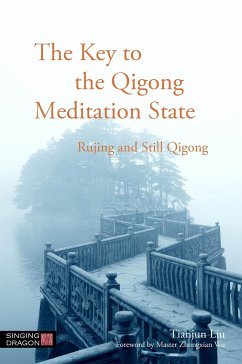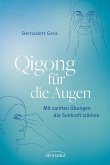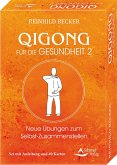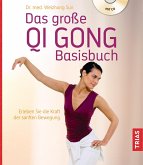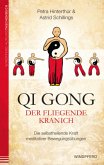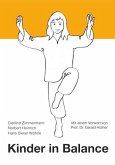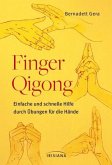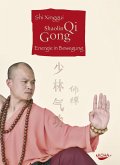- Broschiertes Buch
- Merkliste
- Auf die Merkliste
- Bewerten Bewerten
- Teilen
- Produkt teilen
- Produkterinnerung
- Produkterinnerung
Focusing on Rujing, the meditation state fundamental to Qigong meditation, this ground-breaking book looks at the practice from the perspective of psychology and cognitive science. It describes what happens in mind and body during meditation, and how to reach the state of Rujing.
Andere Kunden interessierten sich auch für
![Qigong für die Augen Qigong für die Augen]() Bernadett GeraQigong für die Augen12,00 €
Bernadett GeraQigong für die Augen12,00 €![Qigong für die Gesundheit 2 - Neue Übungen zum Selbst-Zusammenstellen Qigong für die Gesundheit 2 - Neue Übungen zum Selbst-Zusammenstellen]() Reinhild BeckerQigong für die Gesundheit 2 - Neue Übungen zum Selbst-Zusammenstellen22,87 €
Reinhild BeckerQigong für die Gesundheit 2 - Neue Übungen zum Selbst-Zusammenstellen22,87 €![Das große Qi Gong Basisbuch Das große Qi Gong Basisbuch]() Weizhong SunDas große Qi Gong Basisbuch25,00 €
Weizhong SunDas große Qi Gong Basisbuch25,00 €![Qi Gong - Der fliegende Kranich Qi Gong - Der fliegende Kranich]() Petra HinterthürQi Gong - Der fliegende Kranich12,95 €
Petra HinterthürQi Gong - Der fliegende Kranich12,95 €![Kinder in Balance Kinder in Balance]() Dietlind ZimmermannKinder in Balance26,80 €
Dietlind ZimmermannKinder in Balance26,80 €![Finger-Qigong Finger-Qigong]() Bernadett GeraFinger-Qigong12,00 €
Bernadett GeraFinger-Qigong12,00 €![Shaolin Qi Gong Shaolin Qi Gong]() Shi XingguiShaolin Qi Gong16,95 €
Shi XingguiShaolin Qi Gong16,95 €-
-
-
Focusing on Rujing, the meditation state fundamental to Qigong meditation, this ground-breaking book looks at the practice from the perspective of psychology and cognitive science. It describes what happens in mind and body during meditation, and how to reach the state of Rujing.
Hinweis: Dieser Artikel kann nur an eine deutsche Lieferadresse ausgeliefert werden.
Hinweis: Dieser Artikel kann nur an eine deutsche Lieferadresse ausgeliefert werden.
Produktdetails
- Produktdetails
- Singing Dragon
- Verlag: Jessica Kingsley Publishers
- Seitenzahl: 272
- Erscheinungstermin: 1. Februar 2016
- Englisch
- Abmessung: 228mm x 151mm x 20mm
- Gewicht: 397g
- ISBN-13: 9781848192324
- ISBN-10: 1848192320
- Artikelnr.: 40888990
- Herstellerkennzeichnung
- Libri GmbH
- Europaallee 1
- 36244 Bad Hersfeld
- gpsr@libri.de
- Singing Dragon
- Verlag: Jessica Kingsley Publishers
- Seitenzahl: 272
- Erscheinungstermin: 1. Februar 2016
- Englisch
- Abmessung: 228mm x 151mm x 20mm
- Gewicht: 397g
- ISBN-13: 9781848192324
- ISBN-10: 1848192320
- Artikelnr.: 40888990
- Herstellerkennzeichnung
- Libri GmbH
- Europaallee 1
- 36244 Bad Hersfeld
- gpsr@libri.de
Tianjun Liu, O.M.D., is Director of the Qigong research laboratory at Beijing University of Chinese Medicine where he has taught Qigong for more than twenty years. He is also secretary general of the National Qigong Education and Study Association, secretary general of China Academic Society of Medical Qigong, and the first government approved academic mentor for Ph.D. candidates in the field of medical Qigong in China. For the past decade, Dr. Liu has been Editor in Chief of Qigong Study in Chinese Medicine, the only official Qigong textbook used in universities and colleges of traditional Chinese medicine in China.
Foreword by Master Zhongxian Wu. Preface. 1. Rujing and Qigong. 1.1. Two
Concepts. 1.2. Rujing and Three Adjustments. 1.3. Rujing and the Types of
Qigong. 2. The Realm of Rujing. 2.1. Difficulty in Defining. 2.2. The
Levels of Rujing. 2.3. The Experience of Rujing. 2.3.1. Sensory Experience.
2.3.2. Emotion and Mood Experience. 2.4. Rujing and Motion. 3. The
Mechanism of Rujing. 3.1. The Mechanism of Mind Adjustment. 3.1.1. The
Mechanism of Mind Adjustment. 3.1.2. Sensory Thinking. 3.1.3. Emotion/Mood
Thinking. 3.1.4. Biochemical and Physiologic Functions of Brain. 3.2. The
Mechanism of Breathing Adjustment. 3.2.1. Better Understanding of
Breathing. 3.2.2. Alteration of the Breathing Forms in the Process of
Rujing. 3.2.3. The Mechanism of Inhaling and Exhaling in Rujing. 3.2.4.
Breathing and Vital Energy. 3.3. The Mechanism of Body Adjustment. 3.3.1.
Common Postures in the Process of Rujing. 3.3.2. The Mechanism of the
Postures. 4. The Benefit of Practicing Rujing. 4.1. Curing Diseases and
Illness. 4.2. Keeping You Healthy. 4.2.1. Adjusting Your Body and Mind.
4.2.2. Delaying the Process of Aging. 4.3. Cultivating Your Latent
Potentiality. 4.4. Understanding the Universe. 5. The Preparatory Work of
Rujing. 5.1. Daily Adjustments of Mind and Body. 5.1.1. On Psychological
Aspect. 5.1.2. On Physiological Aspect. 5.2. Preliminary Arrangement before
Practicing Rujing. 5.2.1. Objective Concerns. 5.2.2. Subjective Concerns.
6. Operation of Rujing. 6.1. The Basic Principle of Operation. 6.2.
Operation of Mind Adjustment. 6.2.1. Operation of Thinking. 6.2.2.
Operation of Mood. 6.3. Operation of Breathing Adjustment. 6.3.1. Operation
of Inhale and Exhale. 6.3.2. Operation of Various Breathing Forms. 6.4.
Operation of Body Adjustment. 6.4.1. Basis on Posture Arrangements. 6.4.2.
Gist of Posture Operation. 6.5. Coordination and Unity of Three
Adjustments. 7. Malfunction of Rujing. 7.1. Identity Malfunction and Its
Causes. 7.2. Types and Corrections. 8. Piao Hua Gong. 8.1. Design of Piao
Hua Gong. 8.2. Operating Procedures.
Concepts. 1.2. Rujing and Three Adjustments. 1.3. Rujing and the Types of
Qigong. 2. The Realm of Rujing. 2.1. Difficulty in Defining. 2.2. The
Levels of Rujing. 2.3. The Experience of Rujing. 2.3.1. Sensory Experience.
2.3.2. Emotion and Mood Experience. 2.4. Rujing and Motion. 3. The
Mechanism of Rujing. 3.1. The Mechanism of Mind Adjustment. 3.1.1. The
Mechanism of Mind Adjustment. 3.1.2. Sensory Thinking. 3.1.3. Emotion/Mood
Thinking. 3.1.4. Biochemical and Physiologic Functions of Brain. 3.2. The
Mechanism of Breathing Adjustment. 3.2.1. Better Understanding of
Breathing. 3.2.2. Alteration of the Breathing Forms in the Process of
Rujing. 3.2.3. The Mechanism of Inhaling and Exhaling in Rujing. 3.2.4.
Breathing and Vital Energy. 3.3. The Mechanism of Body Adjustment. 3.3.1.
Common Postures in the Process of Rujing. 3.3.2. The Mechanism of the
Postures. 4. The Benefit of Practicing Rujing. 4.1. Curing Diseases and
Illness. 4.2. Keeping You Healthy. 4.2.1. Adjusting Your Body and Mind.
4.2.2. Delaying the Process of Aging. 4.3. Cultivating Your Latent
Potentiality. 4.4. Understanding the Universe. 5. The Preparatory Work of
Rujing. 5.1. Daily Adjustments of Mind and Body. 5.1.1. On Psychological
Aspect. 5.1.2. On Physiological Aspect. 5.2. Preliminary Arrangement before
Practicing Rujing. 5.2.1. Objective Concerns. 5.2.2. Subjective Concerns.
6. Operation of Rujing. 6.1. The Basic Principle of Operation. 6.2.
Operation of Mind Adjustment. 6.2.1. Operation of Thinking. 6.2.2.
Operation of Mood. 6.3. Operation of Breathing Adjustment. 6.3.1. Operation
of Inhale and Exhale. 6.3.2. Operation of Various Breathing Forms. 6.4.
Operation of Body Adjustment. 6.4.1. Basis on Posture Arrangements. 6.4.2.
Gist of Posture Operation. 6.5. Coordination and Unity of Three
Adjustments. 7. Malfunction of Rujing. 7.1. Identity Malfunction and Its
Causes. 7.2. Types and Corrections. 8. Piao Hua Gong. 8.1. Design of Piao
Hua Gong. 8.2. Operating Procedures.
Foreword by Master Zhongxian Wu. Preface. 1. Rujing and Qigong. 1.1. Two
Concepts. 1.2. Rujing and Three Adjustments. 1.3. Rujing and the Types of
Qigong. 2. The Realm of Rujing. 2.1. Difficulty in Defining. 2.2. The
Levels of Rujing. 2.3. The Experience of Rujing. 2.3.1. Sensory Experience.
2.3.2. Emotion and Mood Experience. 2.4. Rujing and Motion. 3. The
Mechanism of Rujing. 3.1. The Mechanism of Mind Adjustment. 3.1.1. The
Mechanism of Mind Adjustment. 3.1.2. Sensory Thinking. 3.1.3. Emotion/Mood
Thinking. 3.1.4. Biochemical and Physiologic Functions of Brain. 3.2. The
Mechanism of Breathing Adjustment. 3.2.1. Better Understanding of
Breathing. 3.2.2. Alteration of the Breathing Forms in the Process of
Rujing. 3.2.3. The Mechanism of Inhaling and Exhaling in Rujing. 3.2.4.
Breathing and Vital Energy. 3.3. The Mechanism of Body Adjustment. 3.3.1.
Common Postures in the Process of Rujing. 3.3.2. The Mechanism of the
Postures. 4. The Benefit of Practicing Rujing. 4.1. Curing Diseases and
Illness. 4.2. Keeping You Healthy. 4.2.1. Adjusting Your Body and Mind.
4.2.2. Delaying the Process of Aging. 4.3. Cultivating Your Latent
Potentiality. 4.4. Understanding the Universe. 5. The Preparatory Work of
Rujing. 5.1. Daily Adjustments of Mind and Body. 5.1.1. On Psychological
Aspect. 5.1.2. On Physiological Aspect. 5.2. Preliminary Arrangement before
Practicing Rujing. 5.2.1. Objective Concerns. 5.2.2. Subjective Concerns.
6. Operation of Rujing. 6.1. The Basic Principle of Operation. 6.2.
Operation of Mind Adjustment. 6.2.1. Operation of Thinking. 6.2.2.
Operation of Mood. 6.3. Operation of Breathing Adjustment. 6.3.1. Operation
of Inhale and Exhale. 6.3.2. Operation of Various Breathing Forms. 6.4.
Operation of Body Adjustment. 6.4.1. Basis on Posture Arrangements. 6.4.2.
Gist of Posture Operation. 6.5. Coordination and Unity of Three
Adjustments. 7. Malfunction of Rujing. 7.1. Identity Malfunction and Its
Causes. 7.2. Types and Corrections. 8. Piao Hua Gong. 8.1. Design of Piao
Hua Gong. 8.2. Operating Procedures.
Concepts. 1.2. Rujing and Three Adjustments. 1.3. Rujing and the Types of
Qigong. 2. The Realm of Rujing. 2.1. Difficulty in Defining. 2.2. The
Levels of Rujing. 2.3. The Experience of Rujing. 2.3.1. Sensory Experience.
2.3.2. Emotion and Mood Experience. 2.4. Rujing and Motion. 3. The
Mechanism of Rujing. 3.1. The Mechanism of Mind Adjustment. 3.1.1. The
Mechanism of Mind Adjustment. 3.1.2. Sensory Thinking. 3.1.3. Emotion/Mood
Thinking. 3.1.4. Biochemical and Physiologic Functions of Brain. 3.2. The
Mechanism of Breathing Adjustment. 3.2.1. Better Understanding of
Breathing. 3.2.2. Alteration of the Breathing Forms in the Process of
Rujing. 3.2.3. The Mechanism of Inhaling and Exhaling in Rujing. 3.2.4.
Breathing and Vital Energy. 3.3. The Mechanism of Body Adjustment. 3.3.1.
Common Postures in the Process of Rujing. 3.3.2. The Mechanism of the
Postures. 4. The Benefit of Practicing Rujing. 4.1. Curing Diseases and
Illness. 4.2. Keeping You Healthy. 4.2.1. Adjusting Your Body and Mind.
4.2.2. Delaying the Process of Aging. 4.3. Cultivating Your Latent
Potentiality. 4.4. Understanding the Universe. 5. The Preparatory Work of
Rujing. 5.1. Daily Adjustments of Mind and Body. 5.1.1. On Psychological
Aspect. 5.1.2. On Physiological Aspect. 5.2. Preliminary Arrangement before
Practicing Rujing. 5.2.1. Objective Concerns. 5.2.2. Subjective Concerns.
6. Operation of Rujing. 6.1. The Basic Principle of Operation. 6.2.
Operation of Mind Adjustment. 6.2.1. Operation of Thinking. 6.2.2.
Operation of Mood. 6.3. Operation of Breathing Adjustment. 6.3.1. Operation
of Inhale and Exhale. 6.3.2. Operation of Various Breathing Forms. 6.4.
Operation of Body Adjustment. 6.4.1. Basis on Posture Arrangements. 6.4.2.
Gist of Posture Operation. 6.5. Coordination and Unity of Three
Adjustments. 7. Malfunction of Rujing. 7.1. Identity Malfunction and Its
Causes. 7.2. Types and Corrections. 8. Piao Hua Gong. 8.1. Design of Piao
Hua Gong. 8.2. Operating Procedures.

